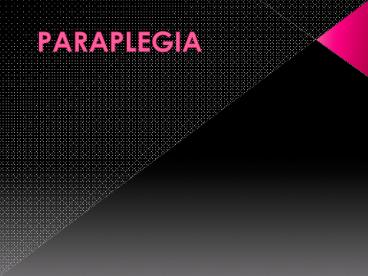PARAPLEGIA - PowerPoint PPT Presentation
1 / 16
Title:
PARAPLEGIA
Description:
Nerve Supply of Bladder Neuronal control of bladder Micturition Centers The Micturition Control Center in Frontal Lobe Inhibitory signals to the detrusor muscle to ... – PowerPoint PPT presentation
Number of Views:2877
Avg rating:3.0/5.0
Title: PARAPLEGIA
1
PARAPLEGIA
2
Extradural
Intradural
3
INTRAMEDULLARY CORD COMPRESSION
- Glioma
- Syringomyelia
- Tuberculoma
- A-V malformations
- Ependymoma
- Hematomyelia
4
EXTRAMEDULLARY
EXTRADURAL
INTRADURAL
- Fracture spine-traumatic
- -pathological Mets, TB .,Osteoporosis
- P.I.D
- Cervical spondylosis
- Spondylolisthesis
- Cranio vertebral anomalies
- Spina bifida
- Meningomyelocoele
- Epidural abscess
- Neurofibroma
- Meningioma
- Malignant metastasis
- Arachnoiditis
- Lipoma, , Fibroma
- Arachnoid cyst
5
NON COMPRESSIVE MYELOPATHY
- MULTIPLE SCLEROSIS
- SYRINGOMYELIA
- SUB ACUTE COMBINED DEGENERATION
- ARTERIOVENUS MALFORMATION
- LATHYRISM
- HERIDATORY SPASTIC PARAPLEGIA
- AMYOTROPHIC LATERAL SCLEROSIS
- PRIMARY LATERAL SCLEROSIS
- RADIATION MYELOPATHY
- ADRENOMYELONEUROPATHY
- PROGRESSIVE ENCEPHALOMYELITIS
- PARANEOPLASTIC MYELITIS
6
CLINICAL PRESENTATIONS
Extradural Intradural Intramedullary
Onset days / weeks Moderately rapid slow
Root pains Localized , asymmetrical involving 1-2 segments , occ.. bilateral Involving many segments , often bilateral Absent , except in syringomyelia
Fasciculation / -
First symptom Motor involvement , weakness Same Sensory . Crossed spinothalemic tract
7
Second symptom Spinothalemic dorsal sensory Same Motor inerveted patern or 2 pattern involvement
Third symptom Late Late to early Early involvement of bladder , later giving rise to automatic bladder
Bowel Late Late to early Firstly constipation followed by incontinence
Reflexes Normal above the level Lost at the level Brisk below Same Same
Spinal tenderness /- Absent
8
Spinal deformity Kyphoscoliosis Localised gibbus or stiffness May be present Absent , unless congenital associated abnormalities with disease like syringgomyelia
papilloedema Absent good Absent Present
CSF examination
Manometry Normal , increased Slightly normal
protein Slightly raised Slightly normal
Xanthochromia / - Negative
Spontenious coagulation / - Negative
Queckenstedts test Modified ask him to cough In 1/3 rd patients its absent
9
Nerve Supply of Bladder
10
Neuronal control of bladder
11
Micturition Centers
- The Micturition Control Center in Frontal Lobe
- Inhibitory signals to the detrusor muscle to
prevent the bladder from emptying (contracting) - Until a socially acceptable time and place to
urinate is available. - Pontine Micturition Center (PMC)
- Coordinates the urethral sphincter relaxation and
- Detrusor contraction to facilitate urination.
12
Role of Pontine Center (PMC)
- Stimulation of the PMC causes
- Opening of urethral sphincters
- Contraction of detrusor
- Resulting in bladder emptying
- The PMC is affected by emotions
- Some people micturate when they are excited or
scared - The ability of the brain to control the PMC is
part of the social training - Usually the brain takes over the control of the
pons at 3-4 years of age
13
Role of Frontal Center
- Stimulation of the Frontal Center causes
- Inhibition of detrusor, until a convenient time
place is available for micturition. - By suppressing the Pontine Center (PMC)
14
Role of Spinal Cord
- The sacral reflex center is the primitive voiding
center - Responsible for bladder contractions
15
(No Transcript)
16
THANK YOU































